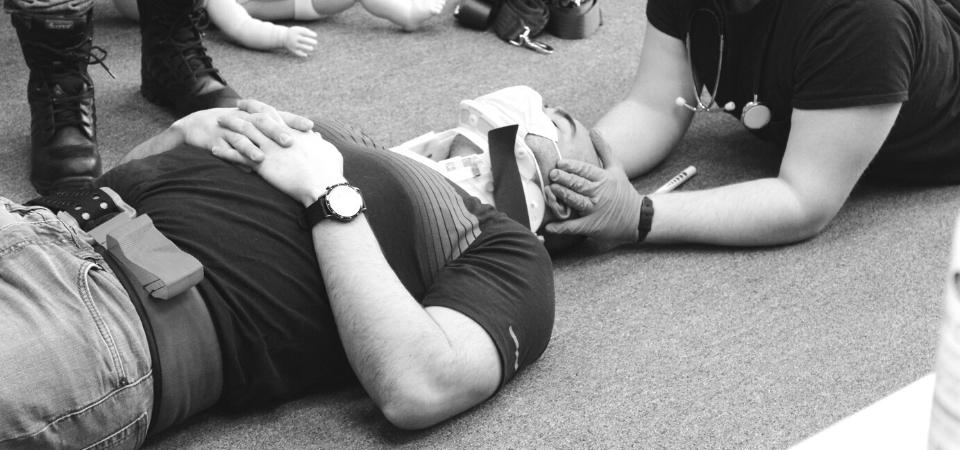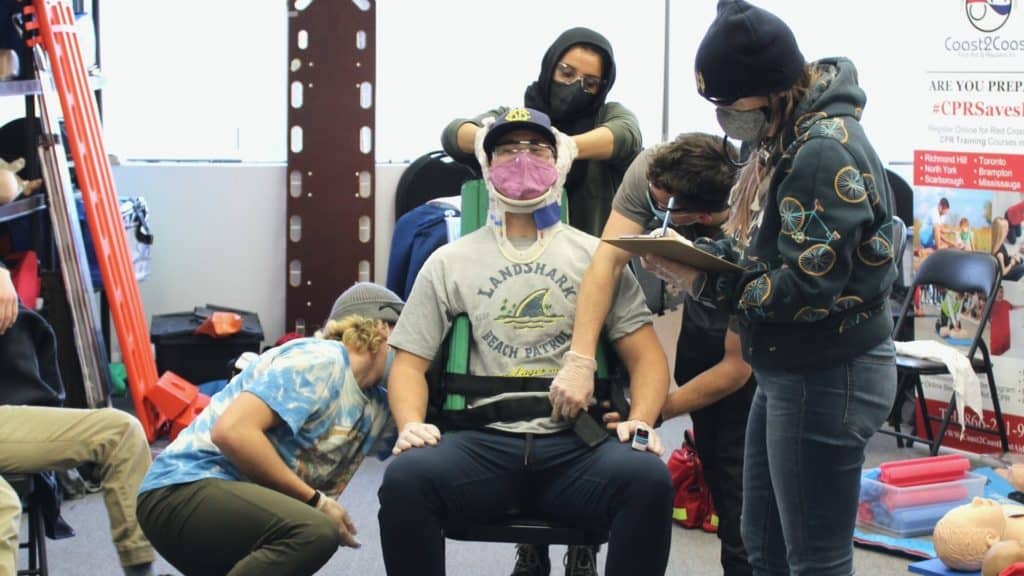Emergency Medical Responder (EMR) courses are far more intense than First Aid CPR training. First responders are trained to provide care in a pre-hospital setting, offering professional life support. During the 8-day (80 hours) course participants cover theory and practical lessons of the different scenarios they will face. They learn how to do a patient assessment and offer life-saving care.
EMRs are crucial in assisting emergency medical providers in many situations, including accidents, life threatening emergencies, emergency childbirth, and etc. Assistance includes helping with a patient’s resuscitation, airway management, providing first aid for wounds and broken bones, and preparing patients for transport. EMR training includes stabilizing spinal and neck injuries, offering protection from infection, controlling bleeding, and stabilizing patients suffering from hyperthermia or exposure to hazardous substances.
Taking the Exam
On completion of the EMR course, in Mississauga, for instance, candidates are required to take the examination to assess their skills. The exam is divided into two sections, the written and the practical test.
What does the practical exam consist of?
During the practical test, candidates are given two complete scenarios to treat. One consists of a medical emergency (e.i Child with asthma) and the other a trauma emergency (e.i burns to chest) which has more complications because of the nature of the injury.
There will be standardized scenarios that contain the context of what has happened to the injured individual along with all the details for the vitals in order to make the scene more realistic. Example below:
“It’s midday on a Saturday in the fall, when you respond to an emergency about a pedestrian struck by a vehicle on a busy street. As you approach the scene, you see that the police have blocked off the street and rerouted traffic; the scene is safe. Upon reaching the female patient, you notice she is not moving. She appears to be in her mid-50s. The police are speaking to witnesses; however, information is limited. The patient is supine on the street, and police state she is approximately 30 feet from where the impact occurred.” (Reference: Canadian Red Cross Society)

Inquire about EMR or FR Training
Scenarios differ in their complexity and the intervention that is expected from the professional responder to perform. However, regardless of the scenario, candidates are expected to successfully demonstrate:
- Scene Assessment
- Environment
- Hazards
- Mechanism of Injury
- Number of patients
- Resources
- Personal Protective Equipment
- Primary Assessment
- Introductions
- Patient Appearance
- Level of Responsiveness
- Spinal Motion Restriction (if needed)
- Airway, Breathing, Circulation
- Skin
- SpO2
- Rapid Body Assessment
- Transport Decision
- Patient Positioning
- Secondary Assessment
- SAMPLE questions
- Pain Scale (OPQRST)
- Vital signs
- Pulse
- Respiration
- Blood Pressure
- Pupils
- Skin
- Level of Responsiveness/ Glasgow Coma Scale
- SpO2
- Body Temperature
- Blood Glucose Level
- Head to toe physical assessment
- Ongoing checking of vitals
Depending on the scenario, there will be at least one injured individual and one bystander present.
Candidates will be completing the scenario in pairs, that is there will be responder 1 and responder 2. The former is expected to take the lead while the latter will provide assistance as some of the interventions may require more than one responder.

What does the written test consist of?
In a test that encompasses the whole textbook, candidates are called to answer 100 questions. The sections candidates are questioned on include:
- Infection control
- Anatomy and physiology
- Assessment of patients
- Airway management
- Circulatory emergencies
- Shock
- Hemorrhage and soft tissue trauma
- Musculoskeletal injuries
- Chest abdominal and pelvic injuries
- Head and spinal injuries
- Acute and chronic illnesses
- Poisoning
- Environmental illness
- Pregnancy, labour, and delivery
- Special populations
- Crisis intervention
- Reaching, lifting, and extricating patients
- Transportation
- Multiple casualty incident
- Pharmacology
- Marine environment
- Workplace
Questions based on patient care are focused mostly on adult and geriatric care, but also include pediatric care.

Questions About FR or EMR?
Preparing for the EMR Exam
Before taking the exam, participants are required to have 100% attendance of the course. They must pay close attention during the course because this is the first step in helping prepare for both the practical and cognitive sections of the exam. All the topics presented by the instructors are critical, and participants are encouraged to ask questions.
Studying is important for passing the exam, and the notes are particularly useful. The questions are multiple-choice, and keep in mind that there is only one correct answer.

Certification
Once emergency medical responders (EMRs)receive their certification, they can save lives by providing immediate aid and interventions for patients during the time before paramedics and more advanced care arrive at the scene. They are also present during the transportation of patients to a hospital.
Their training teaches them to quickly assess a patient and determine the best way to treat them. EMRs also play a vital role in relaying important information concerning the patient’s condition and the initial care they provided to nurses and doctors upon arriving at the hospital. They also clean and disinfect any equipment or supplies that they use while treating a patient.
Once a candidate successfully demonstrates all the above skills in both the multiple-choice and practical scenarios, they are issued their EMR certificate. The certificate is valid for 3 years. Recertification of this program consists of a 4 day (40-hour) session to review all skills and knowledge but the pace will be much faster than the original course.
Locations to Take the Training
Coast2Coast First Aid offers the Emergency Medical Responder course at our locations across Ontario:
North York – #216, 180 Steeles Ave. W, Thornhill, Ontario
Toronto – 635A Bloor St. W, Toronto, Ontario
Markham – #2, 1080 Tapscott Rd, Markham, Ontario
Brampton – 83 Kennedy Rd. S, Brampton, Ontario
Hamilton (Stoney Creek) – #104, 43 Keefer Court, Hamilton, Ontario
London – #304A, 717 Richmond St, London, Ontario
Ottawa – 385 Rideau St, Ottawa
If you have any questions regarding enrollment, please do not hesitate to contact us toll-free at 866-291-9121 or via email at [email protected].




















No comment yet, add your voice below!